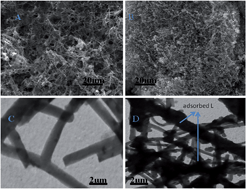A nanocomposite of ferrocenoyl glutaric acid hydrazone and multiwalled carbon nanotubes as a sensor for azide ions†
Abstract
A nanocomposite containing ferrocenoyl glutaric acid hydrazone and multiwalled carbon nanotubes (MWCNTs) has been synthesized and characterized for its structural, morphological and electrochemical properties. Characterization has been done using scanning electron microscopy (SEM), transmission electron microscopy (TEM), thermogravimetric analysis (TGA), infrared (IR), X-ray photoelectron spectroscopy (XPS), and UV-visible studies. The electrochemical behavior and stability of the modified electrode have been investigated using cyclic voltammetry (CV) and differential pulse voltammetry (DPV). A self-standing film of this electroactive and homogeneous composite has been obtained by solution casting method. It is observed that the ferrocenoyl glutaric acid hydrazone (L)/MWCNTs/Nafion composite has better electrochemistry, electrical properties and firm adhesion of the material at the electrode surface. The modified electrode showed an electro-catalytic response to the oxidation of azide ions at the potential of 0.30 V in 0.1 M phosphate buffer solution (pH 7.1). The linear range and detection limit for the azide ion were found to be 0.02 mM to 20 mM and 0.312 μM, respectively.


 Please wait while we load your content...
Please wait while we load your content...